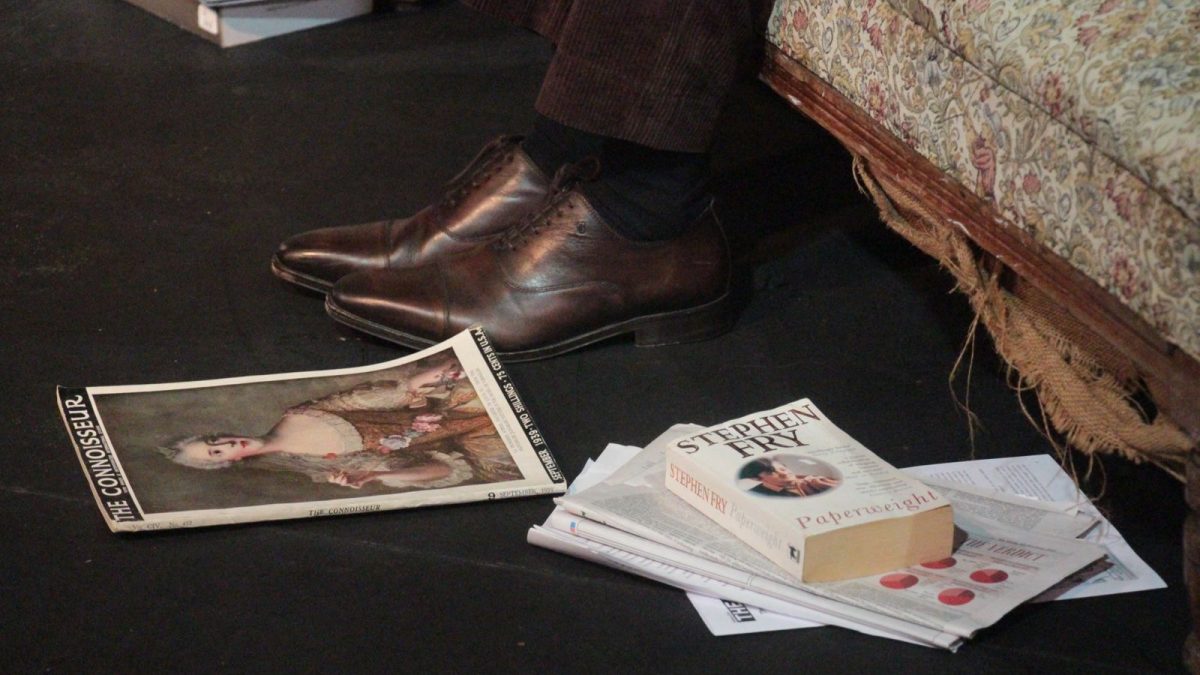Lights up: Vera Lynn’s “We’ll Meet Again” drifts melodramatically through the Burton Taylor Studio as two lovers (Georgina Cotes and Luke Carroll) twirl across the stage, exchanging sweeping, elongated prose. Indeed, their lines are so lofty, so carefully postured, that the audience could be forgiven for assuming this play is a wartime romance.
Turns out they are actors, and we are watching a play-within-a-play (the first of many references to Hamlet). The real drama begins in the entrance of two directors: the tweedy, academic Albie (Peregrine Neger) in full brown corduroy, and the sweary, nebbish Bernard (Tomasz Hearfield) outfitted in a black turtleneck and cowboy boots. In their bickering over the play’s ending, the duo delivers the sharply observant comedy the advertising poster for To What End promises — the audience expectantly laughs at their nervy, neurotic confrontations and their flamboyant intellectual posturing.
Luke Carroll exults in embodying the dreadful method actor, who drifts in and out of his RP-style German accent as he pleases, amping it up to exasperate his irate girlfriend/co-star. Misogynistic tones are skewed for laughs, while Cotes anchors the absurdity, offering the audience a glimmer of reason amid the play’s cheerful nonsense. Their relationship is convincing, and offers a sharp look on modern relationships and political correctness — at one point Cotes hisses: Don’t give me that faux self-deprecating public school act. In response, Carroll shoots back with comic effect: It’s not my fault my parents are successful!
But two gunshots offstage and two dead actors/lovers later, and the play escalates to a telenova-ish drama that teeters the line between droll murder-mystery and intense philosophical discussion.
Bespectacled Albie gets the most monologues, and Peregrine makes full use of them. With his hair brushed up to the nines, perpetually in a Socratic pose (one hand beneath to the chin, brows furrowing as he rocks forward and backward), he leaps deftly from the comic to the dreadful. He’s long-winded and endearingly oblique: a mixture of the smug Polonius and the quick-witted first gravedigger. In combination with Tomasz’s tightly wound Bernard, who has a hilariously inexhaustible supply of neon blue vapes, the whole thing seems like an elongated riff of the gravedigger scene.
It’s pretty clear that the scriptwriters and directors (the two Billys: Hearld and Skiggs) have an English degree between them. The audience is treated to delicious quips like: I tried to write an opera once and it turned into a musical. Perhaps in a sort of nominative loyalty, references to old Bill Shakespeare are bandied about liberally — characters mull over and pedantically quote or dispute Hamlet and Macbeth’s themes: morality and madness, death and life.
You get good value for your time. Hamlet, for instance, is the Bard’s longest play with five acts and over four thousand lines. This runs in at slightly under an hour.
To What End is absolutely mad with textual layers. Even David Foster Wallace would be proud. Plus, it makes fun of its meta-ness: the characters repeatedly question the validity of their lines with wry, cynical self-awareness. It is classic Oxford. Perhaps the directors are from London too: in response to the police’s questioning about the best way to lose a friend (again an echo of Polonius’ advice scene), the loquacious and camp Albie blinks and replies with a flick of the wrist: Deceit… and the London Underground. It’s endearingly student-led too — the judge (Sanaa Pasha) wears a scholar’s gown and a wig made out of partially shredded paper in an attempt to enforce superiority before the two argumentative Oxford academics.
The stage crew delivers. Lighting shifts to sepia for the more romantic bits, and the dramatic spotlighting (deep and impactful) is cleverly played out so that repetition enhances its effect rather than dulling it. The set reflects the characters and their sensibilities: a slim volume of Poetry and Drama by T.S. Eliot, a workbook boldly entitled Drama Guidelines, and two commanding-looking books with JAMES JOYCE written in large capital letters are all displayed prominently by a flowery recliner that Albie and Bernard perch on and alternatingly abandon. There are a few paintings in yellow embossed frames thrown about too, as well as some polaroids of Elvis Presley in the background, just because. The eagle-eyed observer may even notice that there’s a skull with a graduating cap sitting happily above the mantlepiece.
Instead of one mad Danish prince, in To What End every character loses it, rolling in and out of a meta understanding of their roles. What’s the point of the play? What’s the point of anything? To What End outrageously declares that it doesn’t really care. The Billys invite the audience to consider the gaps between the silences. Whatever your theory on its ending, this play is certainly rollicking good fun.
[To What End, staged by B Squared Productions, is running at the Burton Taylor Studio, 4th-8th November 2025]

